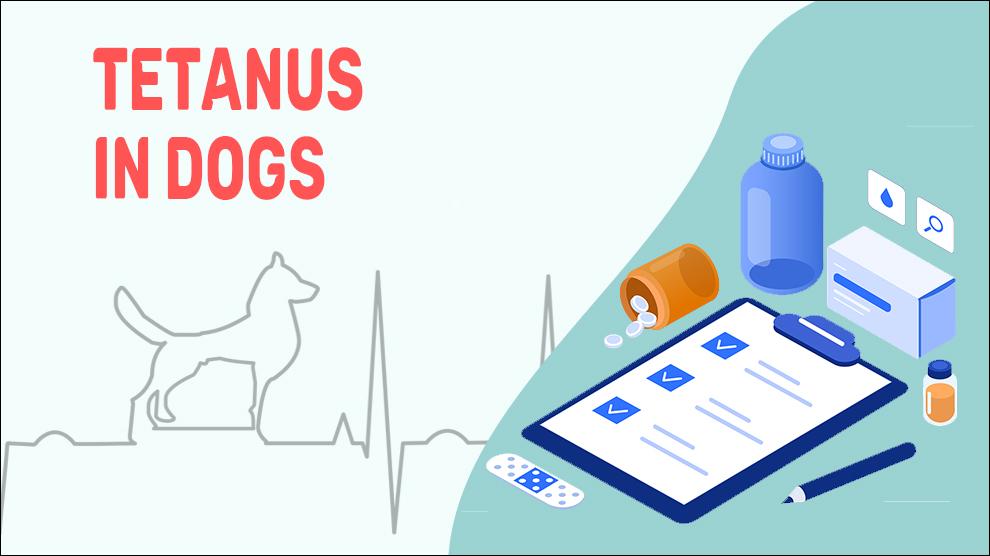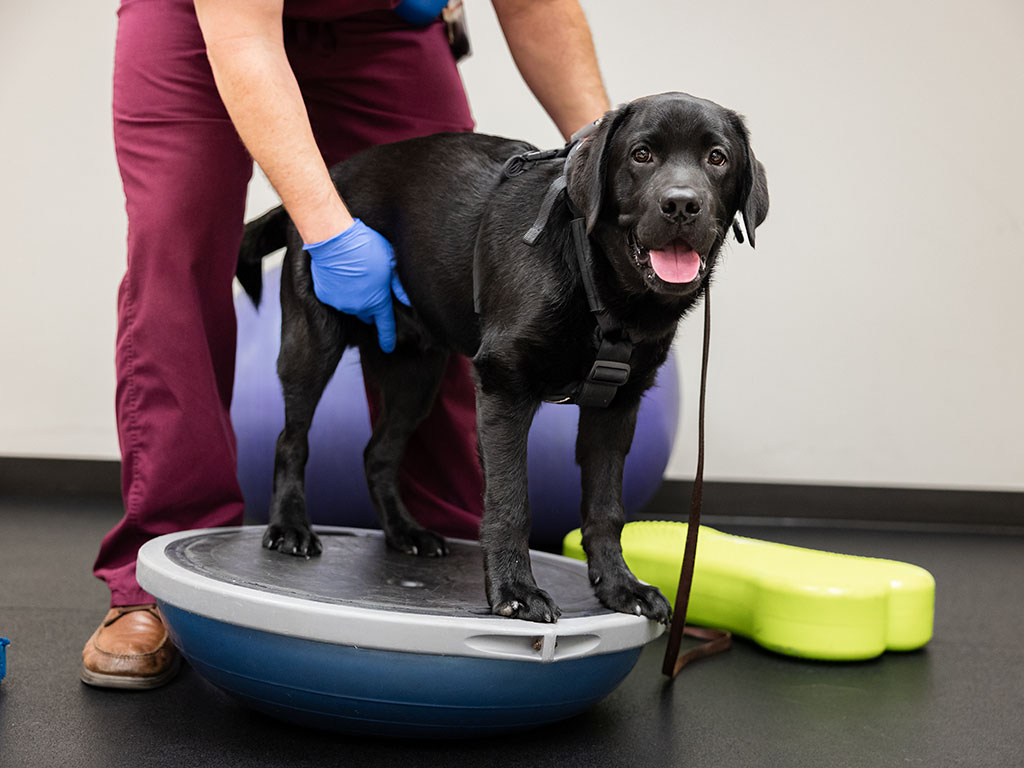Free Shipping On All Orders Over $150.
14 Common Symptoms of Tetanus in Dogs
Tetanus in dogs is a serious health issue that pet owners should be aware of. This disease, caused by the toxin from the Clostridia bacteria, leads to severe complications and can even result in death. Recognizing the signs and symptoms of tetanus is crucial for early intervention and effective treatment. As responsible pet owners, understanding how to prevent this illness is essential to ensuring the well-being of our furry companions.
Tetanus in Dogs

Tetanus in dogs, though less common than in humans, poses a significant risk due to its severe symptoms and high mortality rate. The disease originates from the spores of Clostridium tetani, a bacterium found in soil, dust, and feces. When introduced into a dog's body through a puncture wound or cut, these spores can germinate and produce a potent neurotoxin.
Understanding how tetanus affects pets begins with recognizing its unique behavior within the canine body. The C. tetani spores thrive in anaerobic conditions—environments devoid of oxygen. This characteristic allows them to flourish in deep wounds that are poorly oxygenated. Once inside the body, the toxin travels along the peripheral nerves towards the spinal cord, leading to the well-known symptoms associated with this illness.
Signs of Tetanus Infection
The initial signs of infection may not appear until several days after exposure. Typically, the incubation period for tetanus ranges from three to twenty-one days. Early symptoms often include muscle stiffness and spasms, which can escalate quickly if left untreated.
As the disease progresses, it can lead to lockjaw, a condition where the dog is unable to open its mouth. This is particularly distressing and can impede the animal's ability to eat or drink, leading to further complications. In cases where the toxin spreads through the nervous system, other severe symptoms may manifest, including difficulty breathing and full-body convulsions.
Risk Factors for Tetanus in Dogs
Certain breeds may be more susceptible to tetanus due to their lifestyle or anatomical factors. Dogs that engage in outdoor activities or those who are frequently around farms or rural areas may encounter situations where they could get injured. Moreover, puppies are at an increased risk since their immune systems are still developing, making them more vulnerable to infections.
By paying attention to your dog's environment and lifestyle, you can adopt preventative measures to mitigate the risk of tetanus infection. Regular check-ups with the veterinarian and maintaining good hygiene can also play significant roles in reducing exposure.
Dog Tetanus Symptoms

Recognizing the dog tetanus symptoms is vital for timely diagnosis and treatment. Some of the most common symptoms associated with this condition include:
Muscle Stiffness
One of the hallmark symptoms of tetanus is muscle stiffness in dogs. This stiffness typically starts in the jaw muscles and then progresses to other parts of the body. As the condition worsens, the entire body may become rigid, resembling a plank of wood.
The stiffness results from the effects of the tetanus toxin on the central nervous system, disrupting normal muscle control mechanisms. This state can be incredibly painful for the dog, leading to distress and discomfort. The rigidity can also interfere with the dog's normal movements, making it challenging for them to walk or perform everyday activities.
Lockjaw
The term lockjaw in dogs refers to the inability to open the mouth due to muscle spasms. This symptom is particularly concerning because it restricts the dog's ability to consume food and water. As a result, the dog may exhibit signs of dehydration and malnutrition, complicating recovery efforts.
In addition to physical limitations, lockjaw can have psychological effects on pets, leading to anxiety and agitation. It's essential for pet owners to monitor their dogs closely during this time, as the stress of the situation can exacerbate existing symptoms.
Other Neurological Effects
In addition to muscle stiffness and lockjaw, there are other neurological manifestations of tetanus. Dogs may experience seizures, tremors, and heightened sensitivity to stimuli such as light, sound, or touch. These symptoms can lead to increased agitation and fear, further impacting the dog's overall health.
If you observe any of these signs, it’s crucial to consult with a veterinarian immediately. Prompt action can make all the difference in your dog’s prognosis and quality of life.
Canine Tetanus Signs

When examining canine tetanus signs, it’s crucial to identify not only the physical symptoms but also changes in behavior that might indicate distress.
Physical Examination
A thorough physical examination by a veterinarian is key to diagnosing tetanus. During the exam, the vet will assess the dog's overall condition, focusing on muscle tone and reaction to external stimuli. In many cases, the presence of a wound may signal the source of infection, warranting further investigation.
Signs of pain during the examination can also point toward tetanus, especially if the dog exhibits unusual reactions when touched. The tense muscles and guarding behavior often observed in affected dogs can provide important diagnostic clues.
Behavioral Changes
In addition to physical signs, behavioral changes can indicate the progression of tetanus. A dog suffering from this condition may become withdrawn, showing decreased interest in play or interaction. They might also exhibit irritability or aggression, stemming from the pain and discomfort caused by muscle spasms and stiffness.
Paying close attention to behavioral shifts can help pet owners recognize potential problems before they escalate. If you notice your usually playful dog becoming listless or irritable, seeking veterinary advice becomes critical.
Ongoing Monitoring
Once tetanus is suspected or diagnosed, ongoing monitoring of the dog's condition is necessary. This includes keeping track of the dog’s eating and drinking habits, mobility, and general demeanor. Documenting changes can assist the veterinarian in assessing the effectiveness of treatment plans and making necessary adjustments.
Communication with the veterinarian about any new or worsening symptoms can significantly impact the treatment approach and outcomes.
Muscle Stiffness in Dogs

Muscle stiffness in dogs is not just an isolated symptom but a central component of the tetanus picture. Understanding its nuances is critical for pet owners.
Mechanism of Muscle Stiffness
Muscle stiffness occurs when the neurotransmitters responsible for muscle relaxation are disrupted. The tetanus toxin interferes with the release of glycine, an inhibitory neurotransmitter that functions to relax muscles. Without sufficient glycine, involuntary contractions cause muscles to become tense and unyielding.
This process creates a feedback loop—stiffness leads to pain, which can increase tension further. As a result, the dog's movement becomes increasingly restricted, potentially leading to further injuries or complications.
Impact on Mobility
The consequences of muscle stiffness extend beyond mere discomfort. As the condition progresses, mobility becomes severely impaired. Dogs may struggle to stand or walk, often relying on their front legs while dragging their hind legs, akin to a person with a significant movement disorder.
This lack of mobility can affect the dog’s overall well-being, leading to muscle atrophy over time. Limiting physical activity can also contribute to weight gain, creating a host of additional health challenges.
Long-Term Consequences
If not addressed promptly, muscle stiffness can result in long-term consequences for a dog’s health. Chronic issues such as joint problems and degenerative changes in the musculoskeletal system can arise from prolonged disuse. Therefore, immediate veterinary intervention is essential to manage symptoms and foster recovery.
Proactive care—including rehabilitation exercises, physical therapy, and anti-inflammatory medications—may be necessary to restore function and mobility post-treatment.
Lockjaw in Dogs
Lockjaw in dogs, medically referred to as trismus, is one of the most distressing symptoms associated with tetanus. It significantly impacts a dog's quality of life and can pose serious risks if not treated swiftly.
Causes of Lockjaw
Lockjaw arises from the same muscular disruptions seen in broader tetanus symptoms. The contraction of the jaw muscles prevents the dog from opening its mouth, making it difficult for them to eat, drink, or groom themselves.
This condition can pose a life-threatening risk if the dog cannot intake fluids, leading to dehydration. Additionally, the inability to eat can quickly result in malnutrition, further compounding the health crisis.
Emotional Response
Beyond the physical implications, experiencing lockjaw can be psychologically taxing for dogs. The inability to communicate their discomfort or interact with their owners can generate feelings of isolation and frustration.
Pet owners often observe heightened anxiety levels in dogs suffering from lockjaw. Providing a calm and supportive environment is essential, helping to alleviate some of the emotional distress associated with this condition.
Management Strategies
Managing lockjaw requires a multifaceted approach, combining medical treatment with environmental modifications. Veterinarians may employ medications aimed at relaxing the muscles and reducing spasms, making it easier for the dog to open its mouth gradually.
Additionally, creating a stress-free environment with minimal noise and light can aid in easing the psychological burden on the dog. Offering softer foods or specialized feeding solutions may also be beneficial during recovery.
Tetanus Treatment for Dogs
Addressing tetanus treatment for dogs encompasses a comprehensive strategy involving hospitalization, medication, and ongoing care.
Hospitalization Requirements
Most dogs diagnosed with tetanus require hospitalization to receive continuous monitoring and care. The severity of the condition necessitates round-the-clock observation to manage symptoms effectively and ensure the safety of the animal.
During hospitalization, the veterinarian may administer intravenous fluids to combat dehydration. This step is crucial, especially in cases where the dog has been unable to drink due to lockjaw or severe muscle stiffness.
Medication Protocols
Veterinary professionals typically prescribe a combination of antibiotics to eliminate the underlying bacterial infection alongside muscle relaxants to ease the symptoms. Anticonvulsant medications may also be utilized to control any seizure activity resulting from the toxins affecting the nervous system.
Further, vaccination against tetanus is essential, as it can help prevent future occurrences. Discussing vaccine options with your veterinarian should be a priority after recovering from this illness.
Home Care Considerations
Once stabilized, dogs may be eligible for home care under certain circumstances. However, specific recommendations must be followed diligently to ensure continued recovery.
Creating a quiet, comfortable space for your dog to rest can help facilitate healing. Regularly checking for signs of dehydration and offering soft, easily digestible foods can also support nutritional needs during recovery.
Causes of Tetanus in Dogs
Understanding the causes of tetanus in dogs is crucial for prevention and management strategies.
Sources of Infection
The primary source of tetanus infection is the Clostridium tetani bacterium. These bacteria are commonly found in soil, dust, and manure. Any injury that exposes your dog to contaminated materials increases the risk of infection.
Puncture wounds, especially those from nails, thorns, or sharp objects, are prime entry points for the bacteria. Even seemingly minor injuries can lead to significant health issues if not cleaned and monitored correctly.
Environmental Factors
Dogs that frequent outdoor environments or engage in rough play are at an elevated risk for sustaining injuries that could lead to tetanus. Pet owners must be mindful of their dog's surroundings and take precautions to avoid exposure to potential hazards.
Additionally, conditions that impair wound healing, such as diabetes or immunosuppression, can heighten susceptibility to infections, including tetanus.
The Importance of Hygiene
Maintaining good hygiene practices is vital for preventing tetanus infections. Regular grooming and prompt cleaning of any wounds can significantly reduce the likelihood of introducing harmful bacteria into the body.
Prompt veterinary care for injuries, no matter how small, is also essential. Even minor wounds should be assessed and treated appropriately to prevent complications.
Dog Nervous System Disorders
Recognizing dog nervous system disorders linked to tetanus can aid in understanding the broader impact of this illness on a dog's health.
Neurological Impact of Tetanus
Tetanus primarily affects the nervous system, causing a cascade of symptoms that highlight its disruptive influence. By targeting the central nervous system, the tetanus toxin interferes with normal neurological function, leading to varying degrees of dysfunction.
As mentioned previously, the most notable outcome of this disruption is muscle stiffness, but the ramifications extend far beyond. Dogs may suffer from severe anxiety, confusion, and altered sensory perception as the nervous system struggles to cope with the toxin's effects.
Diagnosis of Neurological Disorders
Diagnosing nervous system disorders in dogs can be complex, often requiring a series of diagnostic tests to rule out other conditions. Your veterinarian may recommend blood tests, imaging studies, or even a lumbar puncture to evaluate neurological function thoroughly.
Early intervention can be crucial, as prompt recognition of symptoms can facilitate more effective treatment and improve prognosis.
Treatment and Management
Managing nervous system disorders involves addressing both the immediate symptoms and the underlying causes. Depending on the complexity of the case, treatment may include medications to alleviate specific symptoms, physical rehabilitation to restore mobility, and ongoing monitoring to prevent complications.
Integrating holistic approaches, such as acupuncture or behavioral therapy, may also enhance recovery processes, providing a well-rounded strategy for managing canine nervous system disorders.
Preventing Tetanus in Dogs
Taking steps to focus on preventing tetanus in dogs can save lives and improve overall pet well-being.
Vaccination
One of the most effective methods of prevention is vaccinating your dog against tetanus. While routine vaccination protocols may vary based on location and exposure risk, discussing the importance of tetanus vaccines with your veterinarian can help determine the best approach for your dog.
Regular vaccination can bolster your dog's immune response to potential infections, providing an essential layer of protection against this serious disease.
Reducing Exposure Risks
Minimizing exposure to potential hazards is another key element in preventing tetanus. Ensuring that your dog's living environment is clean and free from debris can help reduce the likelihood of injury.
Monitoring your dog's playtime and interactions with other animals can also prevent bites or scratches that may introduce bacteria into the body.
Promoting Wound Care
Effective wound care is vital to preventing tetanus. Pet owners should familiarize themselves with proper cleaning techniques for cuts and scrapes, ensuring that any open wounds are thoroughly disinfected and monitored for signs of infection.
If you suspect that your dog has sustained an injury, seeking veterinary advice immediately can greatly reduce the risk of complications, including tetanus.
Dog Vaccination for Tetanus
Dog vaccination for tetanus plays a pivotal role in safeguarding your pet’s health.
Understanding Tetanus Vaccines
Tetanus vaccines work by stimulating the dog's immune system to develop antibodies against the Clostridium tetani toxin. While not included in standard puppy vaccination protocols, the tetanus vaccine may be recommended based on the dog’s lifestyle, health status, and risk factors.
Veterinarians will assess individual risk profiles to determine whether vaccination is appropriate. For dogs at higher risk of exposure—such as working dogs or those frequently outdoors—the tetanus vaccine can provide critical protection.
Vaccination Schedule
Consulting with your veterinarian about an appropriate vaccination schedule is essential. Booster shots may be required at regular intervals to maintain immunity, especially for dogs exposed to environments where tetanus-causing bacteria are prevalent.
Ensuring that your dog is up-to-date on vaccinations can protect against various diseases, and it reinforces the importance of proactive healthcare.
Aftercare and Monitoring
After administering a tetanus vaccine, monitoring your dog for any adverse reactions is crucial. Common side effects may include mild lethargy or local swelling at the injection site. However, severe reactions, although rare, require immediate veterinary attention.
By staying vigilant and maintaining regular veterinary visits, you can ensure that your dog remains safe and healthy throughout their life.
Conclusion
Tetanus in dogs is a serious and potentially fatal condition that requires immediate attention and intervention. By understanding the symptoms, causes, and treatments associated with this disease, pet owners can play an active role in identifying and addressing issues early.
Preventative measures, including vaccinations and proper wound care, can help mitigate the risks associated with tetanus. Ultimately, being informed and engaged in your dog's health is the best way to ensure their well-being and longevity.
0 comment
Be the first to comment